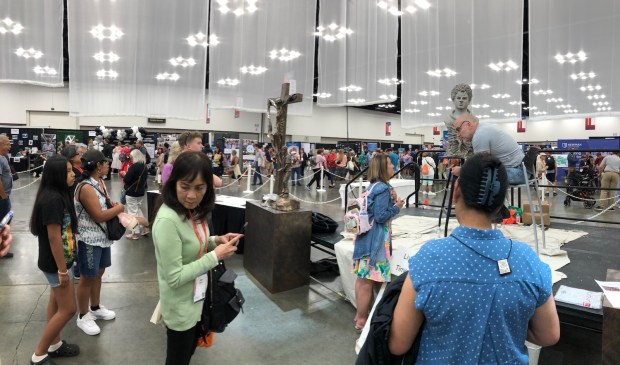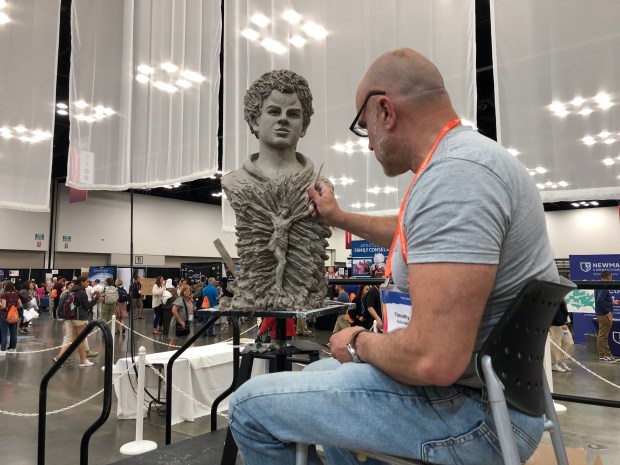At the heart of the vast exhibitor hall of the Eucharistic Congress, you will come upon a surprising sight — a man at work, sculpting clay into human form, kneading small lumps of clay with his fingers, which he refers to as his “rosary beads.”
The sculpture is of a teenage boy with curly hair — and unusually, the crucified Christ is bursting from his chest. That may sound horrific, like something from the movie “Alien,” but the effect is quite the opposite.
This young man is offering God’s love to the world. His name is Carlo Acutis, and his sculptor is Timothy Paul Schmalz.
Aleteia spoke with the renowned artist about his work and the experience of creating a work of art in front of thousands of people.
Aleteia: When did you start the sculpture of Carlo Acutis?
Schmalz: This is very symbolic. I wanted to -- at the Revival, during this event -- create something new. And what better than a new saint celebrating the Eucharist? So it's symbol layered upon symbol.
I started at the beginning [of the Congress,] a couple days ago, and I didn't necessarily know what the sculpture would look like, other than [that it would be] Blessed Carlo. And this is what's formed out here.
Aleteia: What's the experience of actually sculpting it in front of all these people and having all these encounters while you're here? What's it been like for you?

Schmalz: Surprisingly, it's been very, very meditative. One thing is studying the portrait of a saint, and another thing is sculpting it. And it's just, I tell you, it's just a deeper layer when you're face to face with Blessed Carlo for so many hours. Some insight comes out.
Like one of the thoughts I had yesterday is he's like a David. I was thinking about Michelangelo's David or Bernini's David, and especially Bernini's David, if you've seen it. And I thought, yeah, he's like a modern-day David, and the Goliath is mainstream culture, and his sling is the media.
So all these ideas of the saint are being revealed to me as I'm working on this piece.
When I'm working on a sculpture of a saint, I oftentimes think, how would that saint want to be represented? And so throughout this process, I realized that Blessed Carlo would want in his heart what's in his heart, and that is Christ.
And so you see here a representation of Jesus on a cross, crucified, but then the rays coming out suggest the monstrance here. So it's really developing and taking a life of its own.

Aleteia: It's absolutely beautiful.
Schmalz: Thank you. Thank you.
Aleteia: I'm amazed at your process of creation. Usually we think of artists as isolated, working in their studios alone. And for you to say that it's actually been meditative, among all these people -- that's really surprising to me. Do you feel that the presence of all these people even has contributed in any way?
Schmalz: Well, certainly it's very encouraging here at the Eucharistic Congress, seeing so many young people. I think what we have right here is a young Saint for a new generation. So yes, it is completely encouraging: seeing so many people, especially so many people that as I look in their faces, I see the same age, the same spirit as Blessed Carlo here. I think this is a champion for Catholicism today and hopefully the sculptures that I'm doing will promote him.
Aleteia: Do you have a plan for this particular sculpture? Where do you want it to end up?
Schmalz: The symbolic process of creating it is all I'm thinking about right now.
It's interesting, because I consider creating sculpture as a prayer, in a sense. These are my my rosary beads right here, the pieces of clay that I put on. And I think that prayer comes in all different sizes and all different shapes and forms. And this one's forming into Blessed Carlo. So I'm in for the now on this one.
Aleteia: Do you care where your sculptures end up?
Schmalz: One of the reasons I love bronze is because you can put it outside, and so ideally, my sculptures are placed outside to encourage people to go inside. I do believe that sculptures are preachers, and I don't want to see Blessed Carlo in a closet. I want to see him out on the street.
So ideally, the sculptures I'm doing, not only of Blessed Carlo, but other saints and other Scripture [passages] will be placed out, not underneath a table, but on a stand, so people can see it, right?
~
Join us virtually at the Eucharistic Congress with this link.
Find and purchase Schmalz's work here.


